IN THE DEPTHS of it, Rodrigo Garduño wouldn’t even leave his house.
Garduño had played soccer since he was four and signed his first pro contract with the Mexican team Necaxa at age 16. But after a contract dispute in 2007, he ended up retiring earlier than he expected. At just 29 years old, his pro sports career was over, and he wondered if he had a reason to keep living.
For the next two months, Garduño drew the curtains, rarely left his house, and for the first time in his life, stopped working out. He watched his normally cut frame fade to normalcy.
“I woke up one day and said, ‘If I’m going to die, I don’t want to die like someone weak, sitting in the corner of a room. I want to die strong,” he tells Men’s Health. So he started working out again. This time he didn’t have trainers and teammates and a regimented schedule. But he soon developed his own workout, an intense form of circuit training that mixes running and calisthenics in an hour-long program with few pauses. Diving back into a workout routine, he says, quite simply saved him.
Now, Garduño wants to do the same for you.
Garduño, 43, founded the fitness company 54D in 2012 with the intention of helping people keep their bodies and minds healthy. In the past year, when many battled mental demons, 54D—that’s shorthand for 54 days of bootcamp—went from a small network of gyms to an online viral sensation. During the lockdown, Garduño began posting his workouts free online, and it seemed it was just what people needed in those darkest days. His social media presence went from barely existent to a million Instagram followers. His videos attracted tens of thousands of live viewers, and then hundreds of thousands more later on. Among the celebrities who began doing his workouts regularly were former Yankees shortstop Alex Rodriguez and model Adriana Lima.
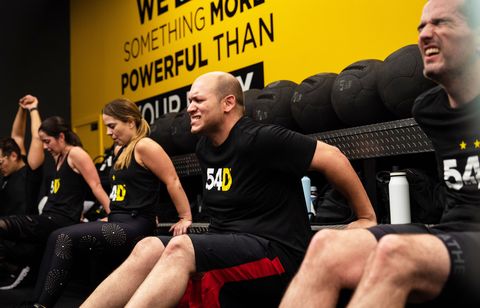
This all happened, he says, because he can provide the one thing that he once felt so empty without. Once he got moving again, Garduño decided to create a sense of community around his workouts, where those who do 54D can help others improve their physical and mental fitness throughout the duration of the emerging fitness empire’s core offering: a grueling, pricy bootcamp that demands strict accountability for about two months straight. “I’ve been on my knees and in bad situations,” Garduño says. “I know that the only way that I stand up and continue going is when I stop making excuses and I focus on how I can be better every day.”
Garduño now wants to open gyms in every major city in America. This is, if enough Americans are willing to embrace his unforgiving training ideal. Because the true challenge of 54D isn’t only cost and intensity: Just like in pro sports, the program demands total commitment. You have to either make gains or get out.
ON A TUESDAY in mid-April, Garduño showed up to his gym in Coral Gables, a tiny suburb of Miami, just before the start of his 9:45 a.m. class. With a Russell Crowe ruggedness and an endearing smile, he fist-bumped and hugged his way through a crowd waiting for class to begin. Spotting the only new person in the room, he locked eyes with me and grabbed the meat of my shoulder, as if both assessing my fitness and in a warm welcome. “Are you working out with me today?” he said with a strong Mexican accent, his voice growly from overwork. “You should work out with me.”
Garduño seems to have a never-empty well of enthusiasm and excitement. His bout with depression after the end of his soccer career made it clear, he says, that working out can offer more than just physical benefits—it’s one key to maintaining a healthy state of mind. After his recovery, and with soccer firmly behind him, he landed a job with a company that supplied inspirational speakers for corporate events. But he wanted to find a more hands-on way to encourage people to keep moving.
In his mind, there was no reason regular people couldn’t commit to a workout the same way athletes committed to get back in shape through mini-camp. He envisioned a gym that would require members to show up six days a week over the course of 54 days. Anyone who didn’t show, arrived late, or simply lacked dedication would be kicked out. Except some investors didn’t love that idea. Gyms survive, they told him, because most paying members like the flexibility of being able to go when they want to, not because they have to. That’s part of why many fitness bootcamps or group class-based exercise programs offer mix-and-match options for clients, who can sign up or drop-in at their leisure, without fear of instructors judging them. Demanding more, it seemed, was simply bad business.
His business plan also sounded flawed because of Garduño’s disinterest in hard-selling former clients into repeating the program. Omar Yunes Márquez, the CEO of 54D, says the goal is instead simply to get people in shape, even if they never come back after completing the program. Many of them do repeat, though—Yunes says they’re seeing a 70 percent return rate. “We’re not here for recurring revenue,” Yunes says. “We’re here to get a result.”
After investors balked, Garduño raised the money from friends and relatives instead. Nine years ago, he opened the first 54D in Mexico City. And right from the start, he charged far more than most other gyms; it’s now $3,900 for the nine-week program.

But Garduño had fans in the region, and his gym quickly became so popular he required tryouts to get in. For 30 spots, 400 people would show up, spending the next two hours working out at a soccer field, Garduño picking only those who were the most committed. He added two more Mexico City locations, and then expanded in 2017 to Bogota, Colombia. He came to Coral Gables in 2019, and while he had to close for the pandemic lockdown, being in Florida meant he could reopen in June 2020. He’s opening a second gym in Miami this October and has plans for three more gyms within the next year, including in New York City and Los Angeles.

On the morning we met, Garduño agreed to allow me to watch a workout for a few minutes. Before opening the door to the gym, he said: “You are about to see in this room something we don’t allow anyone to see.” The gym in Florida is stylish, industrial orange-on-black everywhere, corrugated metal and exposed rafters. There are exercise bikes, free weights, but the thing that’s perhaps most unique is a one-story high running ramp featuring two lanes—one smooth, and one with stairs—along the wall. During a running circuit, members must sprint about 40 feet up and down it. The strongest people have no choice but to elbow past slower joggers, as Garduño stands nearby to clap and shout words of encouragement. These often include a sort of catchphrase: “Vamos, carajo,” which roughly translates to a curse but here is more like, “Let’s go, buddy.”
The hour-long workouts are a mix of aerobics—burpees, mountain climbers, jumping jacks, and sprints. There are few breaks, and most of the cooldowns involve jogging in place to keep heart rates elevated. This type workout should feel familiar to anyone who’s done high-intensity interval training, or HIIT, sharing a lot of the same exercises and intensity. The fact that 54D didn’t invent any new exercises is a truth that Yunes is quick to acknowledge, pointing out that most exercise programs use the same movements. “In the fitness world everybody tries to label the exercises they’re doing. The truth is the exercises we all do are pretty basic,” he says. “We’re using the same things that children use in their PE class.”
People’s instinctive familiarity with these moves may be an advantage when it comes to 54D attracting new clients. “The workouts are more accessible than CrossFit, or even F45 and Barry’s, which can both feel intimidating to some people,” says Men’s Health fitness director Ebenezer Samuel, C.S.C.S. But what makes the workout unique is that Garduño instills a sense of the camaraderie he had on pro soccer teams. Sign up for 54D and you’ll work out with the same 30 people in the same time slot every day, all of them agreeing to a strict low-carb, high-protein diet. “He’s amped the accountability, and thus the mental side of things, while decreasing the physical barrier to entry. He’s using a lot of bodyweight exercises,” says Samuel. “These are friendlier than cleans and muscle-ups and toes-to-bar, which are technically demanding. And from that standpoint, it’s pretty smart.”
Even though he demands a lot from his clients, Garduño says very few give up. That’s in part, he says, because the people willing to meet his requirements aren’t the type to quit. If they’ve got the luxury to dedicate an hour six days a week to the workout, plus the money to afford it, Garduño says that rules out those who won’t fully commit.
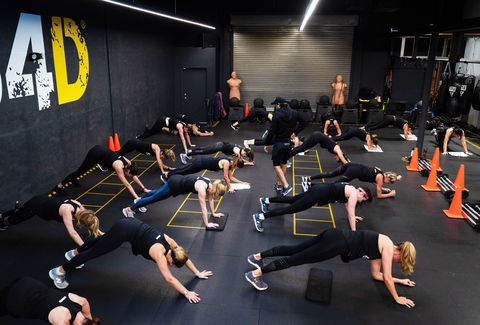
“That part is actually brilliant,” says psychologist and Men’s Health advisor Dr. Drew Ramsey, M.D.. “Rodrigo has captured something that has really been missing” in organized workouts. Ever since playing sports in college, Ramsey has missed the feeling of being part of something bigger. “When you’re accountable to those men and women, you just perform better. It taps into how we’re social creatures.”
While getting kicked out of Garduño’s program for not working hard enough could be tough on those who fail, Ramsey maintains that it’s still a good idea. Too many exercise programs and gyms profit from those who pay for memberships but then don’t show up, so creating rules and boundaries that keep people working out hard will benefit most people who try it. Never mind that by sticking with it, people may be setting themselves up to succeed even more—eight weeks is a pretty commonly accepted standard making a healthy habit change.
Garduño says he has kicked out only about six people in Miami, something he says is justified to keep slackers from bringing down the rest of the group. It happened to a woman who was simply not losing body fat. Garduño says it’s not possible to follow the rules and fail, and so he told her to leave after 10 days. He also seems unafraid of any potential blowback: The woman (who did not respond to interview requests) is an Instagram star, with over a million followers and sponsorships from beauty brands.
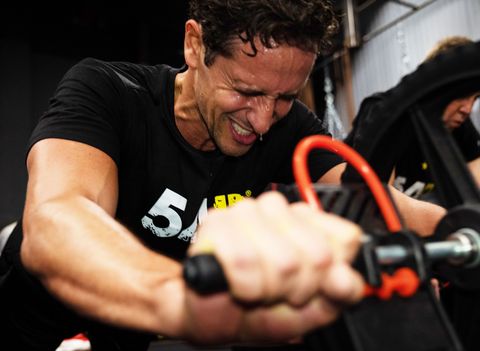
Those unbending requirements make everyone at 54D accountable for each other, says former 54D participant Dr. Allan Stewart, M.D., a 51-year-old cardiothoracic and vascular surgeon in Miami. Stewart’s wife, food TV star Donatella Arpaia, gave him a nine-week boot-camp membership as a Christmas present in 2019. Stewart says he liked how Garduño molds a group of strangers into a team, and it made Stewart feel like he was letting everyone down if he didn’t try harder. He dropped from 17 to 9 percent body fat. “The incredible uniqueness about it is the accountability. It sort of holds up a mirror to you.”
JUST MONTHS AFTER Garduño opened his first U.S. outpost in Miami, the lockdown began. Stuck at home in the same city, where he lives with his wife and two young daughters, he decided he’d start posting his workouts online. That first class, at 11 a.m. March 17, 2020, had 6,000 people watching live. For months, the videos were shot on an iPhone; sometimes the videos were shaky or the sound quality was poor. In a few, Garduño would start posting to Instagram live minutes before he was set up, leaving viewers to watch him getting ready. All of it seemed campy and, perhaps because of the quarantine, endearing, another sign of one of us trying to make it in this crazy new world we had been given.
Garduño is joined in most of his videos with his best friend and partner in 54D, Rodrigo “Rorris” De Ovando, who also played on pro Mexican soccer teams. The two Rodrigos share same kind of inclusive amped-up energy. Speaking a rapid-fire mix of English and Spanish, Garduño’s often hoarse voice fills workouts with life lessons; he switches from explaining jump squats to his three rules for life: bring a good attitude to everything, be better than yesterday, and take everything one step at a time.
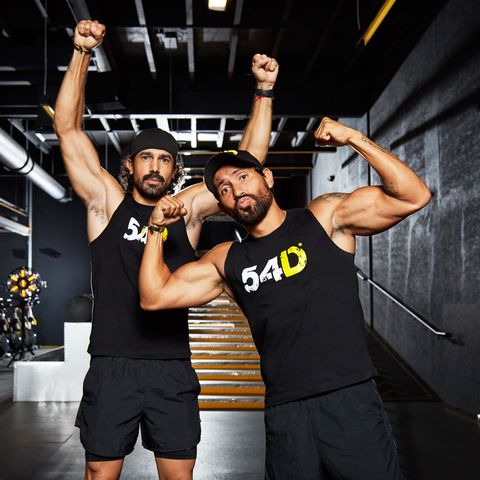
Within a couple weeks of live-streaming, the duo was drawing about 40,000 people to watch live and another 150,000 streaming later. (To put that in perspective, Peloton reportedly set a record during the pandemic with 23,000 live participants.) Sharing videos that offer bilingual encouragement may have helped. How celebrities started doing the workouts is a bit of a mystery, another Internet success story that’s some combination of the right timing, luck, and a catchy product that filled a void.
Among the big-name fans of Garduño is former Yankees catcher Jorge Posada. He signed up for 54D on the advice of his wife, Laura, who is a life coach and had enrolled in her fifth 54D experience in April. For her part, Posada says that she likes how Garduño constantly preaches the mind-body connection to success, with lessons that highlight “whatever you want to do, if you’re not strong mentally, you’re not going to be able to achieve it.”
In June, a year after reopening, 54D added a new series of classes in hopes of getting people to repeat the nine-week program. After more than a year of offering live-streamed workouts for free every day, Garduño now posts workouts to Instagram at 11 a.m. Saturdays, with a recent video collecting 65,000 views. After all the attention to his free videos, 54D launched a $385 app version of the nine-week program, called 54D ON. The workout is similar to the ones offered in the gym, and the app has a messaging system where members can chat with each other and a trainer. But it’s hard to see it as a replacement for the camaraderie of in-person fist-bumps from Garduño and his trainers. Unlike the in-person classes, there’s no way for 54D to know if those who sign up actually do the workouts or keep up with the diet. But enrollees can tap into his inspiration on-demand, which may help build enthusiasm for future gym expansions.
At the end of our interview, Garduño insisted I sign up for the nine-week app-based program. “If you want to be in amazing shape, do it. If you want to change the way your body looks, do it as well,” he said. Refusing to take my non-committal responses, he put out both pinkies, insisting on the kind of promise he asks of his kids. “Believe me,” he said, “this is going to be really good for you.”
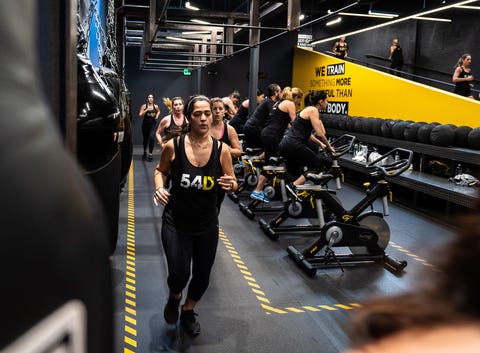
That following Monday, I found myself doing the introductory fitness test of how many exercises members can do in a minute, things like burpees, knee strikes, and push-ups. The more standard workouts began on day two, and they were intense. The two Rodrigos like to say that they offer pro athlete-level training, which apparently comes with deep intuition. Every time I was about to slow down, it was like Garduño knew. He’d chime in with some words of tough-love encouragement. He’ll joke that he’s going to call your mom to pick you up because you just can’t keep going. “Vamos carajo!”
By day four, the first abs workout, flutter kicks defeated me. When the third and final round of the workout began, I considered hitting stop on the video. It was then that Garduño said, “It’s important for you to know the difference between some guy and a champion. The difference is that they always put their hearts and their minds on the field. Not only the physical part, because, I mean you can be an extraordinary athlete in your physical side. But what about your mind? What about your heart?”
And how can anyone quit after that?
Source: Read Full Article
